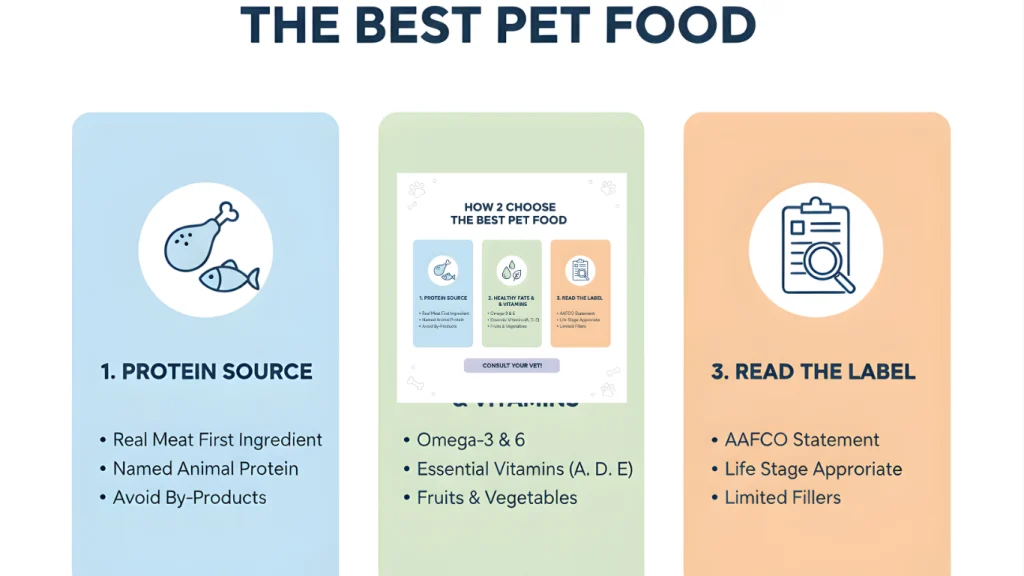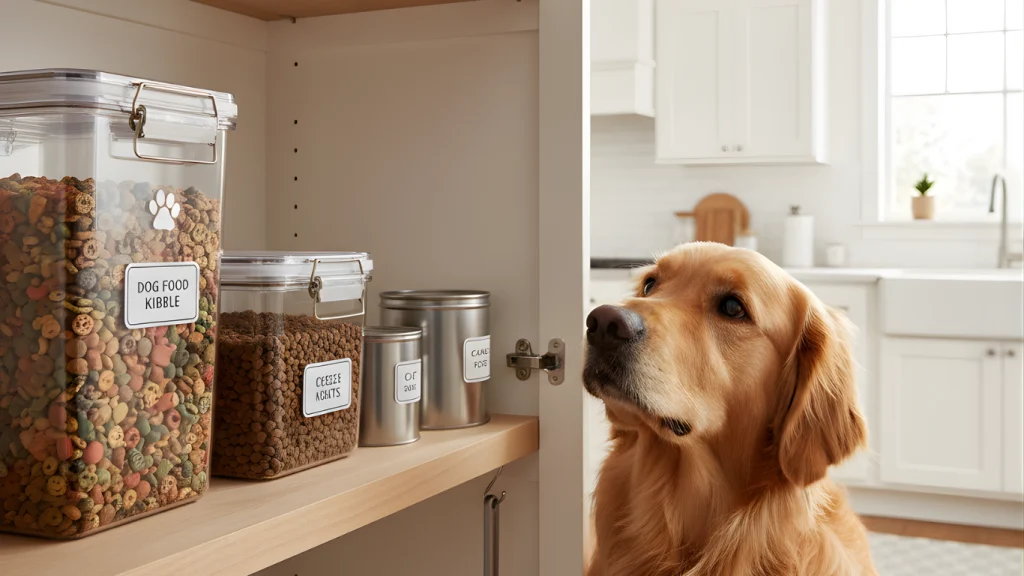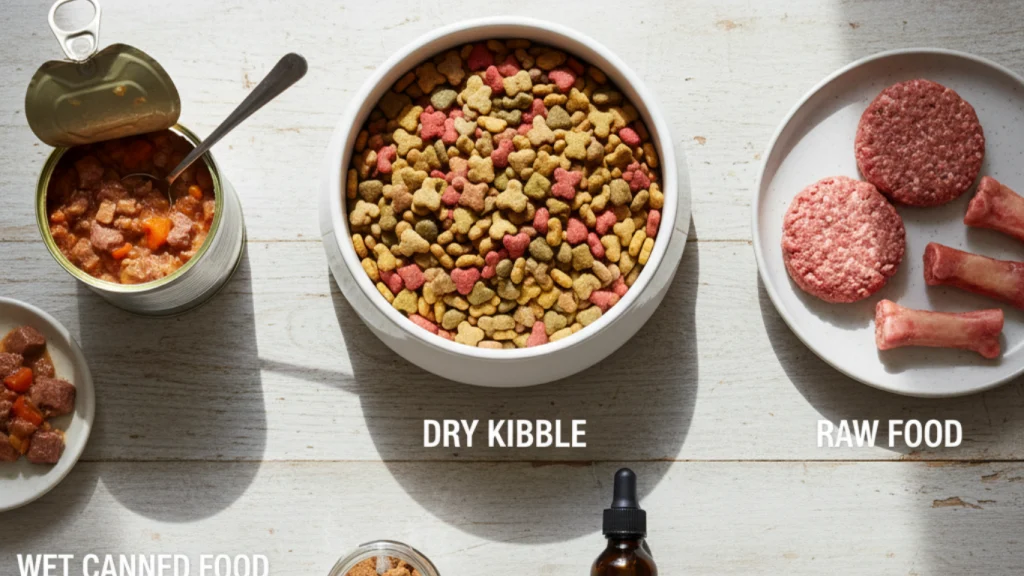Choosing the best pet food is one of the most important decisions for your dog or cat. As a pet owner, one of the most important decisions I make for my dog is what to feed them. It’s more than just filling a bowl—it’s about ensuring they get the right nutrients to support their health, energy, and well-being. Whether you’re bringing a new puppy into your home or caring for an older dog, selecting the best pet food can feel overwhelming, with so many options available. That’s why I’ve put together this detailed guide to help you navigate the world of pet food.
What You’ll Learn in This Guide:
- Why the right pet food is crucial for your pet’s health.The different types of pet food available and what they offer.
- How to choose pet food based on your pet’s age, size, and health needs.
- Key ingredients to look for (and avoid) in pet food.
- Tips on how to store and transition your pet to new food.

1. Why Pet Food Matters: The Foundation of Your Pet’s Health
When I first started choosing pet food for my dog, I didn’t realize just how much of an impact it would have on their overall health. Pet food isn’t just about feeding them—it’s about giving them the right kind of nutrition. Here’s why I believe it matters so much:
Overall Health and Well-Being
The food I give my dog affects their energy levels, immune system, and growth. Proper nutrition strengthens their immune system, helps maintain a healthy weight, and promotes healthy organ function. Good food can even prevent conditions like obesity, heart disease, and digestive issues.
Weight Management
Just like us, our pets can gain weight if they don’t get the right balance of calories. With the right food, I can help my dog maintain an ideal weight. Overweight pets are more prone to health issues, including joint problems and diabetes.
Skin and Coat Health
I’ve noticed that after switching to high-quality food, my dog’s coat became shinier, and their skin appeared healthier. A nutritious diet is key to keeping your pet’s skin smooth and coat thick. Omega-3 and omega-6 fatty acids found in many pet foods help promote healthy skin and a shiny coat.
Longevity and Quality of Life
Pets who eat high-quality food tend to live longer, healthier lives. With proper nutrition, they’re less likely to suffer from chronic conditions, which can lead to a higher quality of life in their senior years.
2. Types of Pet Food: Which Is Best for Your Pet?
Selecting the right type of pet food can be daunting, but once I understood the differences, it made choosing much easier. Here are the most common types of pet food I’ve used for my dog:
Dry Pet Food (Kibble)
Dry food is the most convenient option for me. It’s affordable, easy to store, and often has a longer shelf life. Kibble is also beneficial for my dog’s dental health because the crunchy texture helps clean teeth as they chew.
- Pros: Long shelf life, cost-effective, good for dental health.
- Cons: Can be too low in moisture for pets with sensitive stomachs or certain health issues.
Wet Pet Food (Canned)
Wet food is generally more palatable for dogs and can be great for pets with dental issues or those who need to gain weight. The added moisture also helps with hydration, which is a plus if your dog doesn’t drink enough water.
- Pros: Great for picky eaters, high moisture content.
- Cons: Higher in calories, can be more expensive, and has a shorter shelf life.

Raw Pet Food
The raw food diet has gained popularity among pet owners who want to feed their pets food that resembles their natural diet. While raw food can offer great benefits, it does come with risks if not handled properly, such as bacterial contamination.
- Pros: High in protein, nutrient-dense.
- Cons: Requires careful handling, can be expensive, and may cause stomach upsets in some pets.
Homemade Pet Food
Some pet owners, including myself, choose to cook for their pets. While it’s time-consuming, homemade food allows me to control exactly what my dog eats. However, balancing nutrition is important, so I always consult with my vet to make sure my dog’s diet is complete.
- Pros: Complete control over ingredients.
- Cons: Time-consuming, risk of nutrient imbalance.
Freeze-Dried or Dehydrated Pet Food
These foods are dehydrated to preserve nutrients, offering a balance between convenience and nutrition. Freeze-dried food is easy to store and often more palatable for picky eaters.
- Pros: Nutrient-dense, convenient.
- Cons: Expensive, may need to be rehydrated.
3. Choosing the Right Pet Food Based on Your Pet’s Needs
I’ve learned that choosing the right pet food depends on a variety of factors. Here’s how I decide what food is best for my dog:
Age Considerations
Just like humans, pets have different dietary needs depending on their age. Puppies need food that supports growth, with higher protein and fat content. Adult dogs need balanced nutrition to maintain their health, while senior dogs may require food that supports joint health and reduces calories.
- Puppies: Higher protein, more fat.
- Adults: Balanced nutrition to maintain health.
- Seniors: Joint support, fewer calories, and easy-to-digest food.
Breed and Size Considerations
Smaller dogs have different energy needs compared to larger breeds. Small breeds often require more calorie-dense food since they burn energy faster. Large breeds need food that supports joint health due to their size.
- Small Dogs: Small, high-calorie kibble.
- Large Dogs: Larger kibble and joint-supporting nutrients.

Health Conditions
If your pet has health issues, you’ll want food tailored to their needs. For example, a dog with kidney problems might need special food with lower phosphorus levels. Always consult with your vet if your dog has a health condition that requires a specific diet.
- Allergies: Hypoallergenic food for dogs with sensitivities.
- Digestive Issues: Food that’s easy on the stomach, such as bland diets or food with added probiotics.
- Joint Health: Food with glucosamine and chondroitin for aging dogs.
Activity Level
An active dog will need more calories to support their energy expenditure, while a more sedentary dog might need a lower-calorie diet to prevent weight gain.
4. Key Ingredients to Look for in Pet Food
When I’m picking out pet food, I make sure to check the ingredient list. Here’s what I always look for:
High-Quality Protein
Protein should be the first ingredient in your pet’s food. It’s crucial for muscle maintenance, energy, and overall health. I look for animal-based proteins like chicken, beef, or fish.
Healthy Fats
Fats, especially omega-3 and omega-6 fatty acids, are essential for my dog’s coat and skin health. They also support brain function and help my dog maintain a healthy weight.
Carbohydrates and Fiber
Healthy carbohydrates like sweet potatoes, rice, and barley provide energy and support digestion. Fiber is also crucial for a healthy gut, which is why I make sure to choose food with some vegetables or whole grains.
Vitamins and Minerals
Vitamins and minerals, like calcium for bones and vitamin E for immune health, should be included in high-quality pet food. I check the label to ensure the food is fortified with essential nutrients.
Probiotics and Prebiotics
Probiotics help with digestion, while prebiotics nourish beneficial gut bacteria. These are especially helpful for dogs with sensitive stomachs.
5. Ingredients to Avoid in Pet Food
It’s equally important to avoid certain ingredients that can be harmful to pets. Here’s what I look out for:
By-Products
By-products like “chicken by-product meal” aren’t ideal. They’re lower-quality ingredients that don’t offer the same nutritional value as whole meat.
Fillers
Corn, wheat, and soy are common fillers in low-quality pet food. These ingredients don’t provide much nutritional value, and they may even cause allergies in some pets.
Artificial Additives
Artificial colors, flavors, and preservatives can negatively impact your pet’s health. I always choose food that’s free of these artificial additives.
6. How to Transition Your Pet to a New Food
When switching your pet’s food, I’ve learned that it’s important to do it gradually to avoid upsetting their stomach. Here’s how I do it:
Gradual Transition
Over 7-10 days, I mix increasing amounts of the new food with their old food. This gradual change allows their digestive system to adjust without causing diarrhea or stomach upset.
Monitor for Problems
If my dog shows signs of discomfort, I slow the transition or consult with my vet to ensure the new food is a good fit.
- Storing Pet Food Properly
Proper storage ensures your pet’s food stays fresh and safe. Here’s what I do:

Dry Food
I store dry kibble in an airtight container in a cool, dry place. This keeps it fresh and prevents the growth of mold or bacteria.
Wet Food
Wet food should be refrigerated once opened and used within 2-3 days. I always check the expiration date before feeding it to my dog.
Homemade Food
For homemade meals, I refrigerate or freeze leftovers. I always ensure the food is stored in sealed containers to maintain freshness.
Conclusion
Choosing the right pet food is essential to your pet’s overall health and happiness. By considering your dog’s age, breed, activity level, and any health concerns, you can make an informed decision about the best food for them. Always read the ingredients, look for quality proteins, and choose foods that promote longevity and wellness. And, of course, always consult with your vet if you have any questions or concerns about your pet’s diet.
FAQ Section
- How do I know if my pet is getting enough nutrients from their food?
Check the nutritional breakdown on the label and ensure the food meets AAFCO standards. If your pet is thriving—active, healthy weight, and shiny coat—it’s likely they’re getting the right nutrition. - Can I feed my pet homemade food instead of commercial pet food?
Yes, but it’s essential to consult with a vet or pet nutritionist to ensure you’re providing a balanced diet that meets all of your pet’s nutritional needs. - How often should I change my pet’s food?
If your pet is doing well on their current food, there’s no need to change it unless recommended by your vet. However, as your pet ages or their health changes, you may need to adjust their diet accordingly.
